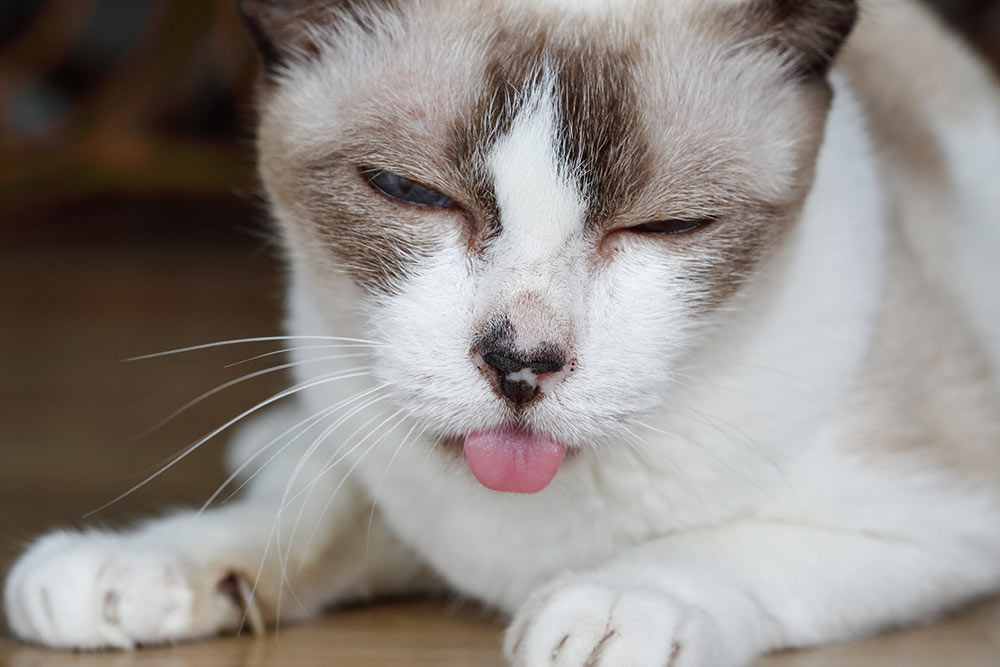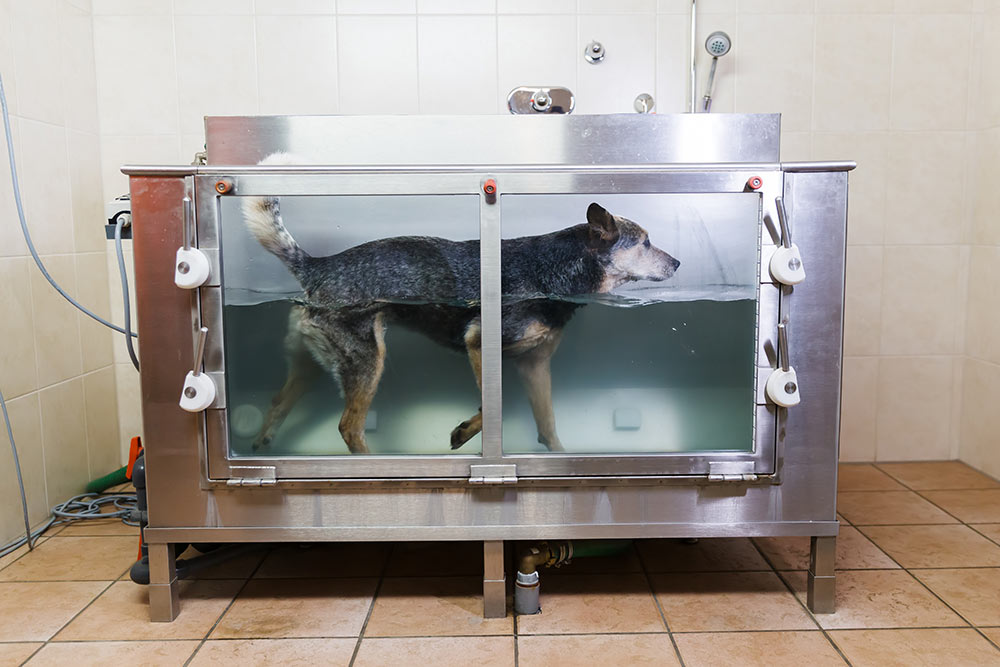Pain in dogs and cats
What is pain?
Pain is defined as an unpleasant sensation that can range from mild, localised discomfort to severe agony. Pain arises from actual or potential tissue damage and resultant nerve stimulation. All tissue injury, including that from surgery, trauma, inflammation and disease, can cause pain. Pain is both a sensory and an emotional experience; therefore, it is very subjective and difficult to measure.
Because dogs and cats have neural pathways and neurotransmitters that are almost identical to those of humans, it is highly likely that they experience pain in a similar way (Source). Just as for humans, pain in dogs and cats can be categorised as either acute or chronic.
Acute pain
Acute pain is sudden in onset and can range from mild to sharp, severe, obvious and distressing. Because acute pain has a specific cause, such as tissue damage, inflammation or a disease process, it disappears when the cause is removed or within a relatively short period of time (from a few minutes to a few months). Acute pain has a biological function; it is an alarm system that provides a warning that something is wrong, leading to behavioural changes that protect the sufferer from more serious injury.
Chronic pain
Chronic pain can last from several weeks to months or even years and persists beyond the expected healing time. This on-going, persistent pain does not perform a biological function; rather, it imposes severe stresses, impacts negatively on quality of life and delays recovery.
Chronic pain can be subtle and masked as “getting old” or “slowing down.” With dogs and cats living longer, there has been an increased recognition of chronic pain associated with certain conditions such as osteoarthritis, stomatitis and intervertebral disc disease. Chronic pain may also occur in the absence of ongoing clinical disease, persisting beyond the expected course of an acute disease process, for example, neuropathic pain following onychectomy (declawing), limb or tail amputation.

Adaptive vs maladaptive pain
Traditionally, pain has been categorised as acute or chronic based on duration, but another approach considers pain as adaptive or maladaptive. Adaptive, or helpful, pain is a normal response to tissue damage in order to promote healing and recovery. Maladaptive, or unhelpful, pain is dysfunctional and non-productive pain that is out of proportion to actual tissue damage and persists after the tissues have healed.
If adaptive pain is not appropriately managed, physical changes can occur in the brain and body, leading to pain that is maladaptive. The longer pain is unmanaged, the more likely the switch from adaptive to maladaptive pain, which is more serious and difficult to treat. An awareness that acute and chronic pain can convert from adaptive to maladaptive pain is helpful in our understanding of why pain can be so difficult to control in some animals.
Inflammation
Inflammation is a major component of acute pain, particularly following surgery or trauma, and is also prevalent in some chronic pain states such as osteoarthritis. Inflammation primarily causes pain because the swelling pushes against sensitive nerve endings, which sends pain signals to the brain. Other biochemical processes also occur during inflammation that affect how nerves behave and can enhance pain.

Symptoms of pain in dogs and cats
There are certain signs and changes in behaviour that can indicate when a dog or cat is suffering from pain. Obvious signs of acute pain, such as howling or crying, will immediately alert the owner to a problem. In general, symptoms of acute pain are likely to be more marked and easily recognisable than symptoms of chronic pain, add are most likely to result in a diagnosis of pain as the presenting complaint.
The behavioural changes associated with chronic pain often develop gradually and may be easily overlooked both by the owner and the veterinarian. Animals are thought to be genetically programmed to hide pain, sickness or weakness in order to avoid drawing the attention of a would-be predator. While the owner is in the best position to detect the subtle signs of chronic pain, such as changes in attitude or interaction with family members, recognising when a cat or dog is in pain can be a challenging task.
Physiological changes
Physiologic changes (those relating to physiology or normal functioning) are used to assess the animal’s response to an acute, noxious (painful) stimulus, particularly during anaesthesia, and to assess pain in some clinical situations. These include changes in:
- Heart rate
- Respiratory rate
- Blood pressure
- Pupil dilation
- Body temperature
Behavioural changes
The most common sign of pain is a change in behaviour. Behavioural expression of pain can vary between species and is influenced by age, breed, individual temperament and the presence of additional stressors such as anxiety or fear. Sporadic observation of the animal’s behaviour may not reveal signs of pain.
Behavioural signs of pain in dogs include:
- Limping, lameness
- Reluctance to move, being less active, refusal to stand up, tending to lie very still
- Becoming withdrawn or restless
- Reluctance to allow touch or to be picked up
- Restlessness (or standing up and lying down repetitively)
- Difficulty getting up from a resting position
- Reluctance to climb stairs
- Trembling or circling
- Seeking more affection than usual
- Panting excessively when at rest
- Hiding
- Protecting a body part
- Acting out of character, e.g. aggressive when normally friendly
- Vocalisation, including:
– Whimpering
– Yelping
– Groaning
– Grunting
– Whining
– Howling
– Growling
- Decreased social interaction
- Anxious expression
- Submissive behaviour
- Guarding behaviour
- Aggression
- Decreased appetite
- Self-mutilation (chewing)
- Changes in posture, e.g., hunching their backs, lying on their side, anything unusual
- Changes in sleeping patterns
- Changes in drinking habits
- Housetraining habits change (accidents)
- Licking
- Biting
- Excessive scratching of a part of their body
- Vacant stare
- Glazed or wide-eyed
- Appears sleepy
- Flattened ears
- Coat lacks normal shine
- Hair stands up in places
Behavioural signs of pain in cats include:
Cats may show pain in many of the same ways as dogs, but may also hide these sign to avoid grooming or turn away from human contact. Other typical behavioural signs of pain in cats include:
- Reduced activity
- Loss of appetite
- Quietness/loss of curiosity
- Inappropriate elimination, changes in urinary/defecation habits
- Hiding
- Hissing or spitting
- Lack of agility/jumping
- Excessive licking/grooming
- Altered posture/gait
- Guarding behaviour
- Decreased grooming/matted fur
- Tail flicking
- Weight loss

Causes of pain in dogs and cats
Many health conditions and medical procedures cause pain in cats and dogs. Some procedures and conditions that are commonly recognised as leading to a diagnosis of pain as the presenting complaint in dogs may be overlooked in cats. For example, osteoarthritis, intervertebral disc disease, and spondylosis are common in older cats, and yet many of the behavioural changes related to these diseases are ascribed to ‘old age’ rather than pain. Cats with behavioural problems often have an underlying medical condition that is causing pain and discomfort; for example, a cat that urinates inappropriately may have painful lower urinary tract disease.
Dogs and cats feel pain from many of the same causes as humans, including:
- Trauma and injury
- Dental problems
- Infections and inflammatory diseases
- Arthritis – osteoarthritis is the most common cause of long-term pain in dogs and may affect at least 25% of the canine population (Source)
- Systemic diseases
- Cancer
Surgical procedures are another common cause of pain in dogs and cats. Procedures that can cause pain and discomfort include:
- IV catheterisations
- Ear cleaning
- Manual stool evacuation
- Anal sac expression (especially in cats)
Conditions in which it is unclear how much pain the animal experiences include:
- Some visceral, gastrointestinal, and urogenital diseases
- Central nervous system disorders
- Dermatologic disease
How is pain diagnosed in dogs and cats?
Because many animals do not exhibit obvious indications of pain, identifying the degree of pain and the amount of suffering it causes can be a challenge. The wide-ranging symptoms of chronic pain (e.g., lack of activity, lack of grooming, decreased appetite, weight loss) are not specific signs of pain and point only to an underlying problem in need of further diagnosis. A significant time commitment is required in the diagnosis and formulation of a treatment plan for animals in chronic pain or where pain is the presenting complaint.
Objective measurements such as heart rate, blood pressure and pupil size have been associated with acute pain. However, these are deemed unreliable indicators of pain as they are also affected by other factors such as stress, fear and drugs. Therefore, evaluation of pain in dogs and cats is currently primarily subjective and based on behavioural signs.
Owner feedback
Owner information is very valuable when assessing chronic pain. Behavioural changes associated with chronic pain in dogs and cats may develop gradually and be subtle; therefore, the owner must be involved in the assessment over a period of time (from weeks to months). Tools have been developed to assess health-related quality of life in dogs and cats with chronic pain.
The categories that are evaluated by these tools include:
- Vitality (e.g., energy, activity)
- Mobility (e.g., tolerance to exercise, stiffness, lameness)
- Mood and demeanour (e.g., alertness, anxiety, playfulness)
- Levels of distress (e.g., vocalisation, response to other pets and humans)
Several questionnaires have been developed which are designed for owners to complete in order to quantify the severity and impact of chronic pain in their animals. These include:
- The Helsinki Chronic Pain Index
- The Canine Brief Pain Inventory
- The Glasgow Composite Measures Pain Scale
- GUVQuest
- Texas VAS Instrument
- Liverpool Osteoarthritis in Dogs
History and physical examination
A thorough history and physical examination are essential to the evaluation when pain is the presenting complaint in dogs and cats. A comprehensive neurological examination should be included for complete assessment and accurate diagnosis of any chronic pain syndrome. Evaluating the degree of lameness and sensitivity to manipulation are also critically important when assessing chronic orthopaedic pain and pain of spinal origin.
Tests
Based on the initial findings, the veterinarian may perform certain tests, including:
- X-rays, for example to confirm the suspicion of a torn ligament;
- Blood work, for example to reveal irritation of the pancreas (pancreatitis), a notoriously painful condition;
- Ultrasound, which can show masses in the belly and can confirm the suspicion of pancreatitis.

Prognosis
In most cases, pain as the presenting complaint can be treated successfully. A good prognosis entails treating the pain itself and diagnosing and treating its cause. The sooner these are diagnosed and treated, the sooner the animal can heal and resume a normal, happy life. Untreated pain decreases quality of life in all patients, and prolongs recovery from surgery, injury or illness.
![]()
Treatment for pain as the presenting complaint in dogs and cats
Pain is a multifaceted phenomenon which differs between individuals and involves both physical and emotional components. In recent years, significant advances have been made in the prevention and management of pain in dogs and cats. Many treatment options are now available, including pain medication, surgery and physical therapies. Yet despite this, pain is still under-treated, largely because of the difficulty in recognising and quantifying it in non-speaking animals.
To treat pain effectively, it must be recognised, identified and measured, so that the efficacy of treatment can be determined. Pain management is generally most successful when implemented early and aggressively. Aggressive treatment of acute pain often prevents wind-up of the nociceptive pathways (those that detect pain), hastens return to normal function and decreases the risk of development of chronic pain syndromes. It is considerably more difficult to manage pain once it is well established.
The treatment of chronic pain usually encompasses both pharmacologic and non-pharmacologic methods. Regardless of the underlying cause, chronic pain is itself a dynamic disease process requiring careful assessment, frequent reassessment and adjustments in therapy over time.
Medical pain management (drugs)
There are many pain medications available for dogs and cats, including anti-inflammatory drugs and opioids (morphine-like drugs). Acute pain is generally treated pharmacologically with one or more analgesics (pain-relieving drugs). Where pain is caused by an underlying condition, medical pain management also plays an important part in the animal’s treatment.
The choice of drug or combinations of drugs is determined principally by the expected severity of pain, health status and suitability of drugs for the animal. The veterinarian will discuss the pros and cons of any medication recommended, especially if for long-term use. Contact your veterinarian immediately if an adverse reaction to any medication occurs.
Pharmacologic treatments for pain in dogs and cats include:
Non-steroidal anti-inflammatory drugs (NSAIDs):
- Have analgesic (pain relieving), antipyretic (fever reducing) and anti-inflammatory properties
- Beneficial across the spectrum of pain intensities:
– The mainstays of treatment for mild to moderate pain
– Part of a multi-modal protocol for moderate to severe pain
- Used for acute and chronic pain including osteoarthritis, cancer and many inflammatory conditions
- Can have occasional adverse reactions which may be variable, subtle, severe or unusual
Opioids:
- Generally derived from morphine, they contain chemicals which relax the body and relieve pain
- Are the basis of effective pain treatment
- Used for mild, moderate and severe pain
- Are potentially addictive
Steroids:
- Can be potent anti-inflammatories
- Have many other uses, including suppressing the immune system
- Commonly have a wide spectrum of side effects, depending on the type of steroid and the dosage administered
Non-pharmacologic methods
Non-pharmacologic therapy can be used as a supplement to medication to boost pain prevention, management and treatment. These methods of pain control are usually used for chronic pain but may also be beneficial in the treatment of acute pain. The selection of the most appropriate non-pharmacologic treatment depends on the underlying cause of chronic pain and the species.
Among these therapies are nutraceutical supplements, dietary modification and many forms of rehabilitation, including acupuncture, low-level laser, massage, and transcutaneous electric nerve stimulation. Many basic lifestyle changes can also help to reduce pain. However, the body of literature critically examining the efficacy of many of these therapies is currently relatively small.
Nutraceuticals:
Nutraceuticals are any substance that is a food or part of a food and provides medical or health benefits, for example, they may decrease inflammation and pain and assist in cartilage repair.
Nutraceuticals that may be used to complement pain management include:
- Omega-3 fatty acids
- Glucosamine
- Chondroitin
- Green-lipped mussels
Dietary modification:
A high-quality diet will help animals to better resist degenerative illnesses and repair damaged or failing tissues. For example, it has been shown that a low-carb, high-protein diet may be beneficial. The veterinarian will advise on the recommended diet for the individual needs of the animal. Dietary requirements and caloric expenditure vary widely between breeds, individuals, and injuries; therefore, close monitoring of any nutritional intervention is critical to the success of the treatment protocol.
Weight management:
Excess body fat strains joints and bones, increasing pain and discomfort. Weight management is recommended to decrease joint stress and improve muscular support of the joints. Weight loss in dogs and cats that are even mildly overweight can significantly reduce pain from osteoarthritis and other orthopaedic conditions. A special diet may be prescribed for this purpose.
Exercise:
Controlled exercise, with appropriate warm-up prior to exercise, is generally recommended. Exercise has many benefits that can help relieve pain; it improves blood and lymph flow, increases soft tissue support to skeletal and spinal structures and increases tendon and ligament pliability.
Rehabilitation therapy (the application of physical therapy techniques to animals)
There are a variety of rehabilitation therapies that may be used to assist in reducing acute pain and returning an animal to normal function following surgery or trauma, or which may be used as a part of a long-term strategy to manage chronic pain.
These include techniques such as:
- Cryotherapy (cooling treatment)
- Thermotherapy (heat therapy)
- Massage
- Stretching
- Passive range-of motion exercise
- Hydrotherapy
- Therapeutic exercise
- Use of dryland or underwater treadmill
- Strength-building
- Low-level laser therapy
- Ultrasound
- Transcutaneous electrical nerve stimulation (TENS)

Lifestyle changes:
- Minimising stress
- Ensuring proper housing conditions
- Providing optimal interaction with other animals and/or people for the particular species and breed
- Providing good nursing care in accordance with the needs of the animal
- Making environmental accommodations to prevent or reduce discomfort, including:
– Easy access to litter boxes (no hood, ramp, or stairs and a low-entry side)
– Soft bedding
– Raised food and water dishes
– Non-slip floor surfaces, especially in food and litter areas
– Baby gates to prevent access to stairs
– Modified access to outdoors, especially in hot or cold weather

In summary
Pain is a complex experience with physical and emotional components. Pain can be acute or chronic, persisting over weeks, months or even years. Recognising pain in animals can be difficult, as they tend to mask their pain. Signs of pain in dogs and cats may therefore be very subtle, or they may be more obvious behavioural symptoms such as crying, whimpering or howling, limping, hunching their backs or avoiding touch.
Pain is very subjective and difficult to measure. Pain assessment tools such as questionnaires can assist the diagnostic process, while certain tests may help in diagnosing pain, including x-rays, ultrasound and blood work. Pain should be treated as soon as possible. There are many options to treat pain in animals including pain medications, nutraceuticals and various physical rehabilitation therapies. It is also necessary to diagnose and treat any underlying condition that may be causing the pain.
Bow Wow Meow Pet Insurance can help protect you and your pett should an unexpected trip to the vet occur.
-
Find out more about our dog insurance options
-
Find out more about our cat insurance options
-
Get an instant online pet insurance quote


More information
- https://ivapm.org/common-signs-pain-dogs-cats/
- https://www.vetwest.com.au/pet-library/pain-how-can-you-tell-if-your-dog-is-in-pain
- https://www.petmd.com/dog/care/evr_dg_managing_pain_in_dogs
- http://www.pethealthnetwork.com/dog-health/dog-diseases-conditions-a-z/dogs-cats-and-pain
- https://www.msdvetmanual.com/management-and-nutrition/pain-assessment-and-management
- https://journals.sagepub.com/doi/pdf/10.1016/j.jfms.2007.09.001
- https://www.vin.com/apputil/content/defaultadv1.aspx?id=7259410&pid=14365&
- https://www.vin.com/apputil/content/defaultadv1.aspx?id=7259412&pid=14365&









